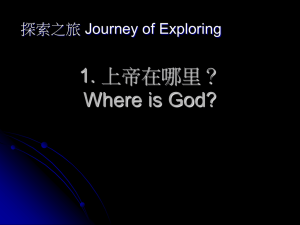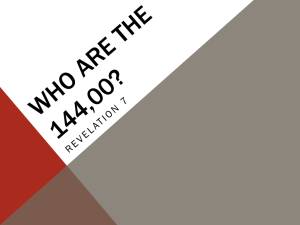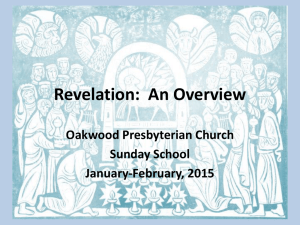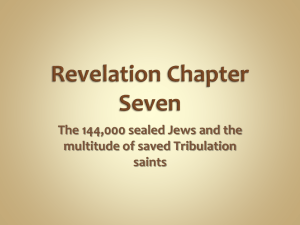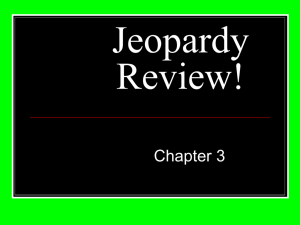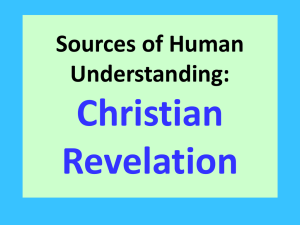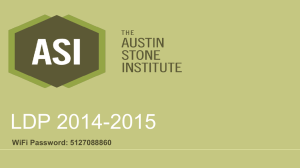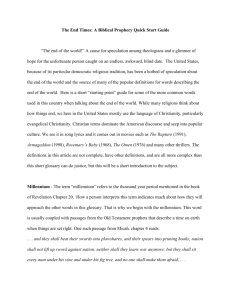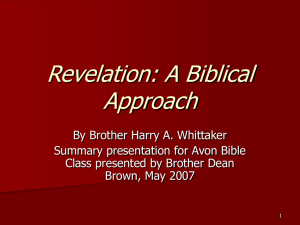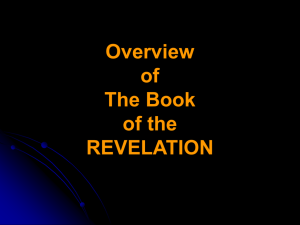Revelation Resources
advertisement
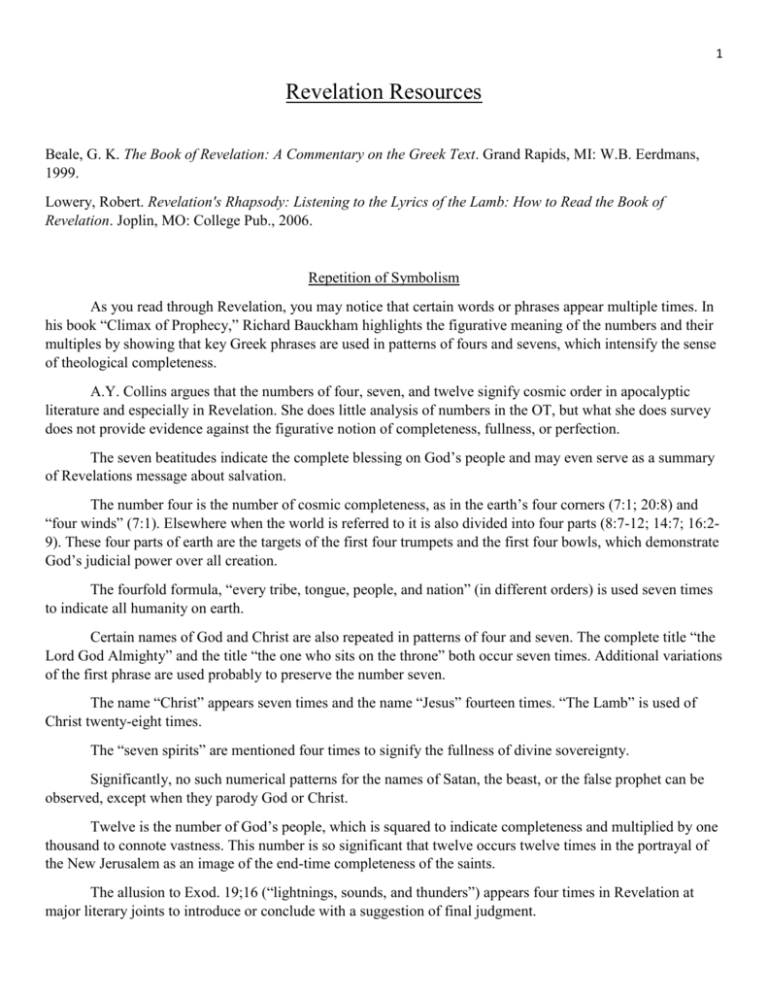
1 Revelation Resources Beale, G. K. The Book of Revelation: A Commentary on the Greek Text. Grand Rapids, MI: W.B. Eerdmans, 1999. Lowery, Robert. Revelation's Rhapsody: Listening to the Lyrics of the Lamb: How to Read the Book of Revelation. Joplin, MO: College Pub., 2006. Repetition of Symbolism As you read through Revelation, you may notice that certain words or phrases appear multiple times. In his book “Climax of Prophecy,” Richard Bauckham highlights the figurative meaning of the numbers and their multiples by showing that key Greek phrases are used in patterns of fours and sevens, which intensify the sense of theological completeness. A.Y. Collins argues that the numbers of four, seven, and twelve signify cosmic order in apocalyptic literature and especially in Revelation. She does little analysis of numbers in the OT, but what she does survey does not provide evidence against the figurative notion of completeness, fullness, or perfection. The seven beatitudes indicate the complete blessing on God’s people and may even serve as a summary of Revelations message about salvation. The number four is the number of cosmic completeness, as in the earth’s four corners (7:1; 20:8) and “four winds” (7:1). Elsewhere when the world is referred to it is also divided into four parts (8:7-12; 14:7; 16:29). These four parts of earth are the targets of the first four trumpets and the first four bowls, which demonstrate God’s judicial power over all creation. The fourfold formula, “every tribe, tongue, people, and nation” (in different orders) is used seven times to indicate all humanity on earth. Certain names of God and Christ are also repeated in patterns of four and seven. The complete title “the Lord God Almighty” and the title “the one who sits on the throne” both occur seven times. Additional variations of the first phrase are used probably to preserve the number seven. The name “Christ” appears seven times and the name “Jesus” fourteen times. “The Lamb” is used of Christ twenty-eight times. The “seven spirits” are mentioned four times to signify the fullness of divine sovereignty. Significantly, no such numerical patterns for the names of Satan, the beast, or the false prophet can be observed, except when they parody God or Christ. Twelve is the number of God’s people, which is squared to indicate completeness and multiplied by one thousand to connote vastness. This number is so significant that twelve occurs twelve times in the portrayal of the New Jerusalem as an image of the end-time completeness of the saints. The allusion to Exod. 19;16 (“lightnings, sounds, and thunders”) appears four times in Revelation at major literary joints to introduce or conclude with a suggestion of final judgment. 2 The word “woman” occurs ten times and “bride” three times and “saints” fourteen times, all as expressions for the community of God. The term “Babylon” and its description as “great” could be used six times in order to associate it with the beast to indicate incompleteness and imperfection. Bauckham concludes that some of these numerical patterns may be accidental. It is improbable, however, that the majority are coincidental because there are so many of these patterns and because these patterns involve the Apocalypse’s most crucial theological and anthropological terms. These symbols are intended to encourage and advise the audience. They portray a transcendent new creation that has penetrated the present old world through the death and resurrection of Christ and the sending of the Spirit at Pentecost. John seeks to motivate the readers not to compromise with the world but to align their thoughts and behavior with the God-centered standards of the new creation. They are able to see their own situation in this world in the light of the new world, which is now their true home. The Structure and Plan of John’s Apocalypse The most plausible outline divides the book into seven or eight sections: 1-3 Initial Vision and Seven Churches 4-7 God’s Throne and Seven Seals 8-11 Seven Trumpets and the Church’s Witness 12-14 Cosmic Battle between God and Satan 15-16 Seven Bowls of God’s Wrath 17-19 God Defeats Evil 20-22 Final Judgment The dominant themes from 6:1 to 20:15 are, in order of importance, judgment, persecution, and salvation/reward. These themes intensify as the book progresses. Many deduce that this rising intensity is evidence that the book is in chronological order. The sheer number of parallels and their repeated usage, however, point to a structure of recapitulation. For an example of this, view the chart on the attached sheet which compares the seven trumpets and the seven bowls. 3 Comparing the Trumpets and the Bowls One way that we see repetition and recapitulation in Revelation are in the accounts of the trumpets and bowls. Many of these scenes echo vocabulary and describe similar events. Some events in Revelation do not all form a continuous series, but rather some scenes recapitulate the events of other scenes. The Seven Trumpets 1. Hail and fire, with blood, cast to the earth. A third of the earth is burned (8:7). 2. The mountain of fire is cast into the sea. A third of the sea is turned to blood (8:8-9). 3. A burning star called Wormwood falls on a third of the rivers and wells of water (8:1011). 4. A third of the sun, moon, and stars are darkened (8:12). 5. A demonic locust plague. The sun was darkened. Locusts were given authority to injure people as from the sting of scorpions (9:1-12). 6. Loosing of angels at the great river Euphrates. An army of two hundred million horses with tails like serpents with power to kill people. People did not repent (9:13-21). 7. “The kingdom of the word had become the kingdom of our Lord and his Christ” (11:1419). The Seven Bowls 1. Poured out upon the earth – evil boils appeared on men who had the beast’s mark (16:2). 2. Poured upon the sea – it became blood, and all life died (16:3). 3. Pouted out upon rivers and wells of water – they became blood because the blood of saints and prophets was shed (16:4-7). 4. Poured out upon the sun – it burned people, but they did not repent of give glory to God (18:8-9). 5. The kingdom of the beast was darkened – although in great pain, people blasphemed the God of heaven and did not repent of their works (16:10-11). 6. The great river Euphrates was made bitter. A way was opened for the kinds of the east. Froglike spirits gathered all kings to the great war of Armageddon (16:12-16). 7. “It is done.” The Final Judgment upon Babylon, with giant hailstones. Yet people still blasphemed God (16:17-21). Bible Genres Old Testament History: Genesis, Exodus, Leviticus, Numbers, Deuteronomy, Joshua, Judges, Ruth, 1 Samuel, 2 Samuel, 1 Kings, 2 Kings, 1 Chronicles, 2 Chronicles, Ezra, Nehemiah, Esther Poetry: Job, Psalms, Proverbs, Ecclesiastes, Song of Solomon Prophecy: Major Prophets: Isaiah, Jeremiah, Lamentations, Ezekiel Minor Prophets: Daniel, Hosea, Joel, Amos, Obadiah, Jonah, Micah, Nahum, Habakkuk, Zephaniah, Haggai, Zechariah, Malachi New Testament Biography: Matthew, Mark, Luke, John History: Acts, Paul’s Letters: Romans, 1 Corinthians, 2 Corinthians, Galatians, Ephesians, Philippians, Colossians, 1 Thessalonians, 2 Thessalonians, 1 Timothy, 2 Timothy, Titus, Philemon Other Letters: Hebrews, James, 1 Peter, 2 Peter, 1 John, 2 John, 3 John, Jude Apocalypse: Revelation
